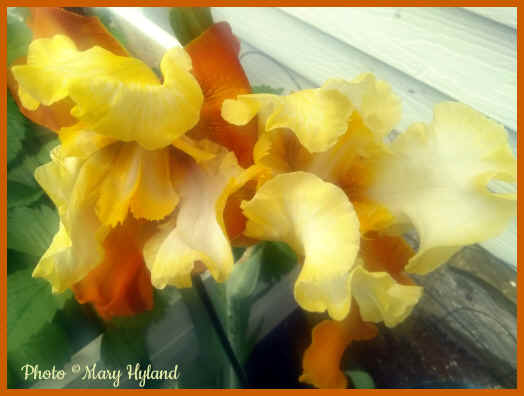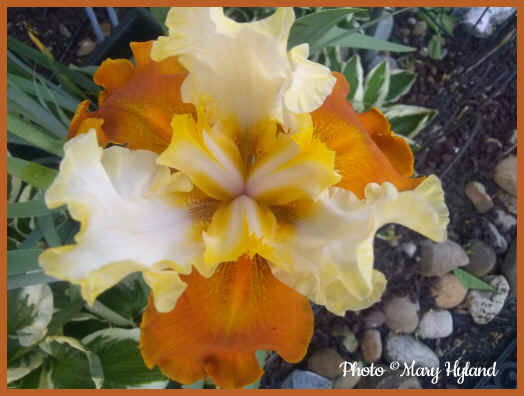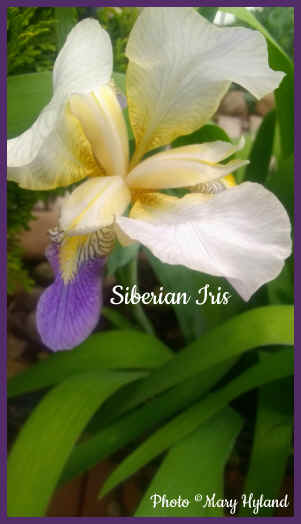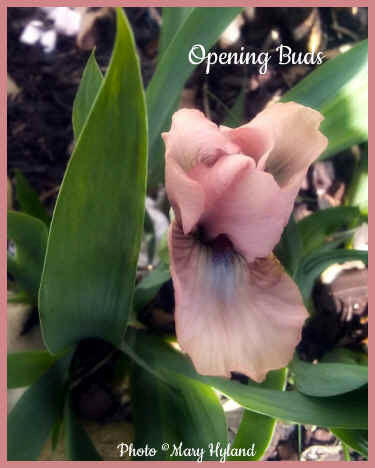 |
|
The Legend of The Iris According to Greek mythology, when the gods wanted to communicate with us mere mortals on earth, they sent a messenger. That messenger was a goddess who, with golden wings, traveled to earth on a rainbow. Legend has it that wherever this goddess set foot on earth, colorful flowers popped up from the ground. The goddess was Iris, and the flowers that were said to grow where she walked bear her name. In the Greek language, the word “iris” means rainbow. And the iris can certainly be found in nearly every color of the rainbow. It is a flower that is artistically breathtaking.
I no longer know the names of the irises I've grown in the past 30 years. Tags always go missing, and I adopt dozens of rhizomes. These are the lovelies in my gardens, and some photos of varieties available from nurseries. I collect all types, but my favorites are dwarf, mid-size, and re-blooming. I adore Irises. The irises and lilies are the stars of my gardens from spring until mid-summer, when the Giant Hibiscus steal the show. Irises have a beautiful Zen look, and they look great among the plants in my Asian-style gardens. They look especially pretty near water - birdbath fountains, little water features, and in galvanized tubs in any garden theme. Irises are also mentioned in plantings for dedicated Mary Gardens. It was a favorite of The Blessed Virgin. Growing tall white irises, along with white Madonna Lilies is a spectacular sight. Here's a look at how you can create a dedicated Mary Garden designed according to Catholic custom and specifications within, or as an add-on for your garden. Mine is created as part of a front yard Patron Saints of The Garden theme, which includes sculptures of Mary and St. Francis of Assisi, as well as Mother Nature, so I could be a little free-wheeling in how I represented my saints and my garden retreat. My favorite spot for Irises is in the Zen garden - bright white irises are a backdrop for a large Buddha sculpture. I do zero maintenance, except to cut the leaves into small fan shapes when they begin to look sad in the fall. Most keep their leaves and they're a pretty dark green, strap- or sword-like. Leaves should be left on for a good while after blooming to create the sugars and nutrients the bulb needs to produce incredible flowers in spring, early summer, and with rebloomers, fall. Leaves should be left on the plant in spring after flowering if you're growing rebloomers, because they need to produce that energy for fall blooming and next spring's show. Irises are easily moved and transplanted. I've even forgotten I pulled some to transplant and they're still plantable and healthy weeks after being yanked out of the soil. The one chore you would have is dividing the plants if you haven't done it in a few years, or planted too close, and staking and tying the tall varieties. The stems are brittle and will snap if a good wind passes through if you don't. If you have an ornamental or privacy fence around your garden, it's a perfect place to prop up tall varieties, with medium and dwarf varieties in front. Louisiana Irises are perfect for damp spots, water features, marginal pond areas and tubs filled with water, with or without much soil. They can also be grown anywhere in a garden, and are perfect for pots and window boxes. They're quite pretty, small-flowered and dainty, and should be planted in clumps for best effect. These and Siberian Irises are the little irises you see in the supermarket bouquets in early spring when very little else is available. Irises are very easy to propagate - just yank a clump every couple of years, separate the spreading and multiplying rhizomes, and make new plants. That's It. These flowers are not picky at all, I grow them in every garden situation. They're gorgeous when planted en masse, and when used as cut flowers. I have not seen any evidence of disease or pests on my plants, and I've never had irises that didn't bloom.
|
 |
 |
 |
| Plant them in a sunny
spot in late summer. The plants need well-drained soil and at least six
hours of sunlight per day. Officially. My experience: They'll grow anywhere and you can plant them any time you like. I've tossed some accidentally into a yard debris pile, and when I finally noticed, they already took root in a week. Planting beds should have soil that isn't hard-packed. Although I've grown them in rock gardens where they've actually pushed small rocks out of the way. You can definitely plant irises in containers and pots for the patio, deck and porch. I created some large container plantings using irises with Creeping Jenny at the base. The bright green-yellow draping groundcover looks amazing with irises in white, yellow, or dark purple. Do NOT plant them too deep, of you won't ever see flowers. They should be planted shallow, with just an inch or two of soil on top of the rhizome. Over time, you'll see rhizomes that have multiplied without division actually sit on top of the soil in the bed. Those should have been divided and the divisions re-planted, but the Iris is tough. It'll do it's best to grow anyway. |
 |
 |
 |
Plant in groups of 3 or
5. They will certainly multiply, so a small number per grouping is best.
They need room and will make room by spreading out anyway. I suggest
that rhizomes be planted a foot apart for large varieties. I clump
smaller varieties in groups of 5, with about a foot between clumps.
Planting one here and one there, especially with tall varieties, does
not look very attractive. Grouping them has a lot of impact. If you
plant tall, medium and dwarf together with the tall in the back against
a fence, or the tall in a row down the middle of a bed, it's a beautiful
sight. You need to stake the taller varieties, or they will just keel
over and look sloppy, or the stems will just break and snap off.
Do not apply organic mulches. You want to avoid rot, because the rhizomes are not planted deep, and mulches mat and clump. I outline and mulch some of my beds with pebbles or rubber mulch. It stays put and doesn't mat over the hibernating bulbs. White pebble or black rubber mulch is a beautiful contrast and has an elegant Zen or Asian look. Prune back the foliage in the fall. I cut my leaves down into short fan shapes and let them be. If I'm dividing and storing, I'll cut them down further, but I still leave some part of the tops on. Check for the need to divide the clumps regularly, because Irises do love to multiply. Even if you're covering a large area, because the rhizomes will be too clumped together and growing on top of each other. If I divide, I just cut the leaves down to a small fan shape, grasp the leaves together near the bottom and give a hard yank. Out they come. If deeper, you can dig them out, but be careful about cutting into the rhizomes. If you do cut them by accident, it probably won't matter. I've planted pieces and they still grow. Most Iris varieties grow in USDA Zones 3-10. They are perennial in those zones and there is no need to store or cover these rhizomes for winter, so let them be. There are so many beautiful varieties of Iris that you'll have a hard time choosing. They are very beautiful in any garden design theme you can imagine. They're so easy to grow, your only problem will be lifting and gifting some when you have absolutely no room left to grow them. |
 |
 |
 |
If you would like to see more of my garden irises, visit my photo gallery-->
|
Quick Links |
Content, graphics,
photos and design ©2020 marysbloomers.com
All rights reserved.





